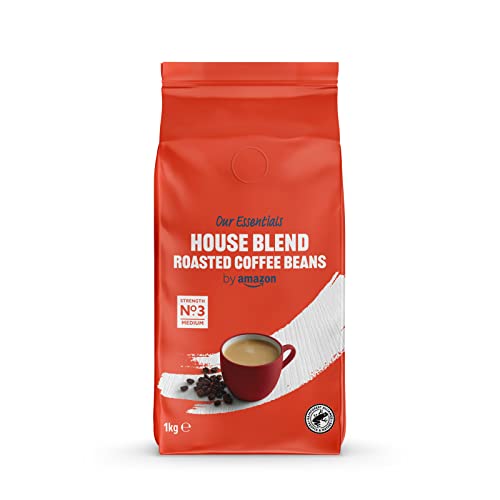9 Lessons Your Parents Taught You About 1 Kg Coffee Beans
페이지 정보
작성자 Joanna Solis 댓글 0건 조회 4회 작성일 24-12-27 11:45본문
 Why Buy Whole Coffee Beans in 1kg Bags?
Why Buy Whole Coffee Beans in 1kg Bags? A kilo of coffee beans would make around 142 single-serve cups. This assumes that there are no spills or waste.
A kilo of coffee beans would make around 142 single-serve cups. This assumes that there are no spills or waste.A tablespoon of whole beans contains about 7 grams. If they are ground a tablespoon could contain more or fewer grams. This is due to variations in the size and density.
Cost
Coffee beans are becoming increasingly important as more coffee drinkers understand the value of brewing an excellent cup of coffee at home. It is smart to buy whole, fresh, high-quality coffee beans in 1kg bags. This will delight your palate as well as your wallet. 1kg of beans will make between 55 and 100 cups, depending on the strength of your coffee.
The price of a kilogram of coffee beans is influenced by many factors, including processing and transport costs. While these fees may seem to be small but they can quickly mount up and affect the cost of the beans. The cost of a kilogram of coffee beans could increase when the roasting process is disrupted or if the bean quality isn't satisfactory.
In addition to these costs aside from these, there are many other indirect expenses that coffee farmers must consider when planning their budgets for their harvests. These expenses include export taxes, the contribucion-cafetera tax charged by FNC, and port fees. Some importers charge management and administrative fees which can be astronomically high.
Another aspect that affects the cost of a 1 kg coffee beans of coffee beans is the roasting coffee is sold for. Prices for coffee beans are based on green coffee prices and can fluctuate greatly. The price of green coffee is also dependent on the region and country where it's produced.
It is also important to consider any coffee waste generated during roasting or processing when calculating the cost per kilogram of beans. For example, coffee beans 1kg arabica waste that is generated by the grinder's plates could reduce the weight of the beans. This allows for an accurate calculation of the amount of servings that a kilogram of coffee beans create.
In addition, the kind of roasting method is also important to determine how many cups of coffee a 1 Kg Coffee Beans of beans will yield. A light roast is sweet and delicate and a deeper roast is more rich and fruity. The amount of coffee that is produced per kilo also depends on whether you are using espresso or filter brewing.
Environment
The environment impacts the production of coffee beans, and a number of environmental concerns are associated with the beverage. Deforestation, water pollution and soil erosion are just a few of the environmental problems. Some larger coffee companies have taken steps to lessen their environmental impact, but there is still much work to be accomplished. This includes encouraging sustainable farming practices and providing financial support for initiatives to protect the environment.
Several papers have examined the impact of climate change on the production of coffee. They have discovered that climate has a significant impact on the quality and yield of coffee beans. The impact of climate changes on coffee production is contingent upon the type of coffee bean and the farming method employed. The beans grown by farmers in shade have a greater flavor, acidity and aroma as compared to those that are grown in sunlight. In addition, the beans produced by farmers who employ Agroforestry techniques are generally characterized by more flavor, aroma, and acidity than those cultivated in monocultures.
The excessive use of chemicals is another major problem in the coffee production. These chemicals are not only harmful to humans, but they also pollute the water. This is particularly relevant to non-organic coffee that makes use of synthetic pesticides and fertilizers. The chemicals that are used up can leak into water and disrupt ecosystems. This could be harmful to humans and wildlife.
The high cost of producing coffee may cause it to be unaffordable for many families. Furthermore, the lack of consistent rainfall could have a negative effect on the harvest. This is because the conditions for growing coffee are extremely specific and a lack rain could result in a poorer crop.
Climate change will have a major impact on the ability of the land to grow coffee. According to research, a significant decrease in suitable land and an increase in areas unsuitable for coffee production will occur in all of the major coffee beans 1kg arabica-producing countries. This will cause conflicts between the production of coffee and conservation of nature. This will also reduce the amount of ecosystem service offered by coffee-growing regions, such as providing support or regulation.
Experimentation
Coffee beans are a versatile food that can be enjoyed in a variety of ways. The bitterness of coffee beans can be diminished by using the right ingredients. They can be used to make coffee or as a component in baked goods. They can also be added into desserts to add flavor and texture. Coffee beans are a great source of antioxidants that can be utilized in many recipes.
The taste of coffee is different according to the region in which it is grown, and its particular characteristics are determined by climate elevation, elevation, and soil quality. The methods used to prepare the beans may alter the flavor. For example, honey processed coffees tend to have a sweeter, fruitier taste than conventionally-processed coffees. These types of coffees are growing in popularity among consumers. They are typically cheaper than traditional coffees. They are also more difficult to grow and require a higher amount of expertise on the part of the farmer.
Besides caffeine, coffee has significant amounts of phenolic compounds that are powerful antioxidants. One of the most important phenolic compounds are chlorogenic acids. They are created by esterifying quinic acid and one or more trans-cinnamic acid. It has been proven that coffee can reduce and inhibit oxidative damages, as well as reduce the production of inflammatory mediators.
Infusion is one of the most well-known ways to prepare coffee. It is one of the most popular ways to prepare. There are a myriad of varieties you can choose from. It can range from classic flavors like chocolate or cinnamon to more exotic ones like ginger, lemon and orange. Certain of these flavors originate from the coffee beans, while others are added during roasting.
Another method to test the taste of coffee is to brew it using different methods. You can try experimenting using a more coarse grind to make a stronger brew or brew it at a higher temperature. These experiments can help you identify your preferred brewing style.
Another interesting experiment using coffee is to sprinkle grounds on the soil of a potted plant to observe how it affects its growth. Many similar experiments have been conducted and, in most cases those plants that received ground coffee grew faster than those that didn't.
Taste
The flavor of coffee is a matter of personal preference. The best way to discover the best flavor is to play with different grind sizes, brewing methods or even blending coffee. You can experiment more when you buy by kilogram. This can result in satisfaction. It's also more cost-effective in the long run, because buying by the kilo helps reduce packaging waste. The coffee grounds that are a by-product of your daily brews can be composted. The purchase of bulk quantities is a greener alternative.
If you're new to espresso it is likely that you'll need to work through several 250g bags in order to get your extraction dialled in. This isn't a rare occurrence and is a crucial element of learning curve. You can purchase beans by the kilo that will help get you through the initial stage and possibly assist you in moving on to other brewing methods after you've achieved proficiency.
You'll save money by purchasing the kilo instead of smaller bags, as packaging and delivery costs are lower. By buying by the kilo, it can also reduce your carbon footprint. This is because you use fewer bags, and fewer degassing and sealing strips than if you purchased one or two 250g-bags at a time. The smaller number of bags used will also result in less waste going into landfills.
Another advantage of buying by the kilo is that it permits you to experiment with different flavors and roasts that can be a satisfying experience for coffee lovers. Moreover, you can easily find a roaster and supplier who offer discounts on larger purchases. You can also order online and have the beans delivered directly to your doorstep which is a great option for busy people.
You can also opt for an option that includes the tamper mat, which allows you to attain the precision and consistency that is required to make a perfect espresso shot. This tamper mat is made from top-quality materials and is extremely durable. It is non-slip and reduces noise, while ensuring that you apply the right amount of pressure to the beans.
- 이전글시알리스 판매하는곳 비아센터정품 24.12.27
- 다음글English argumentative essay samples 2025 T92PBh 24.12.27
댓글목록
등록된 댓글이 없습니다.